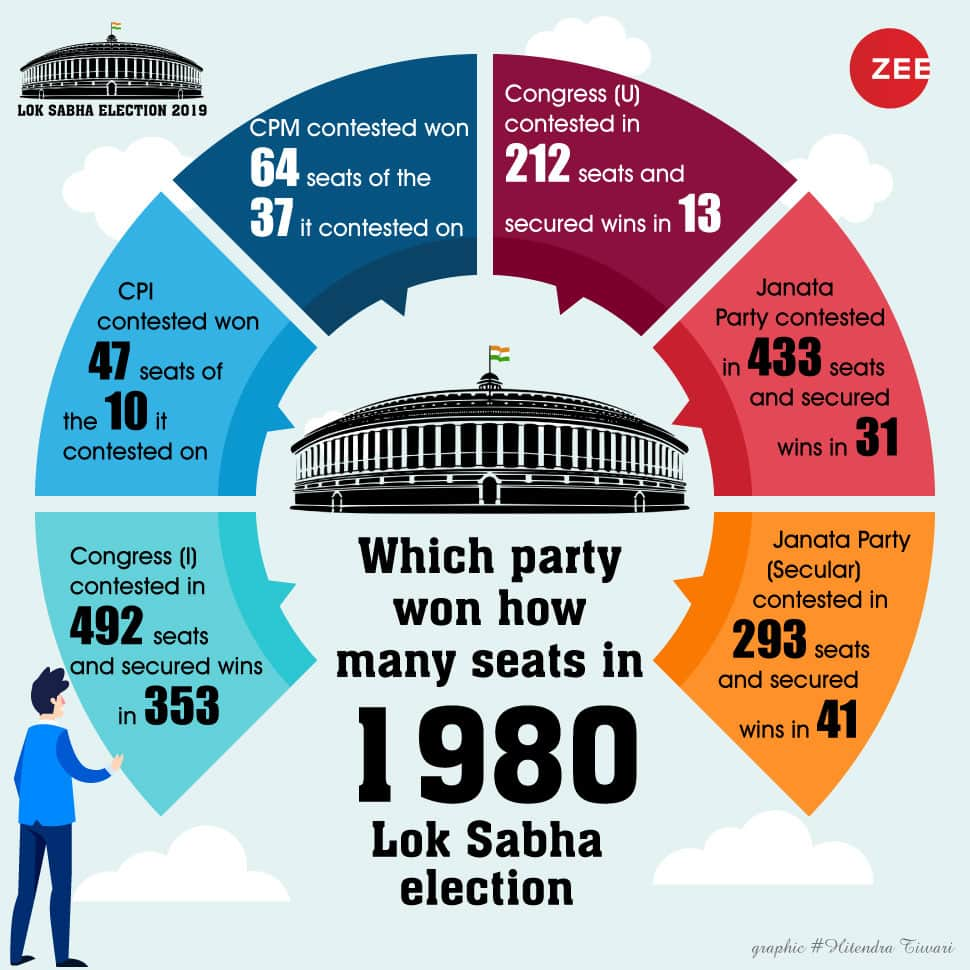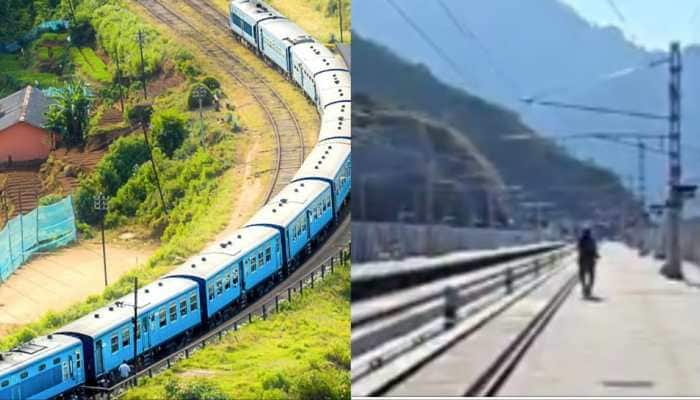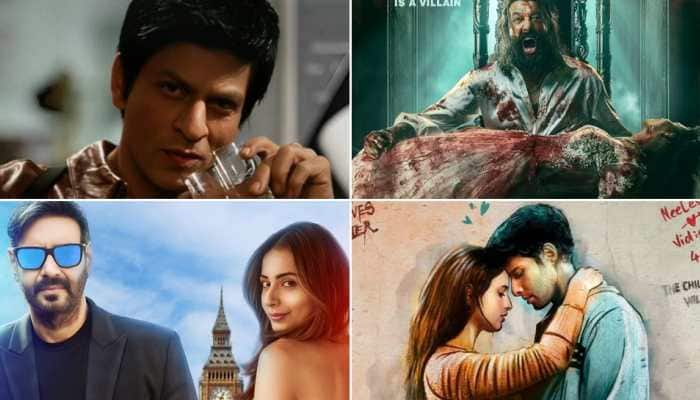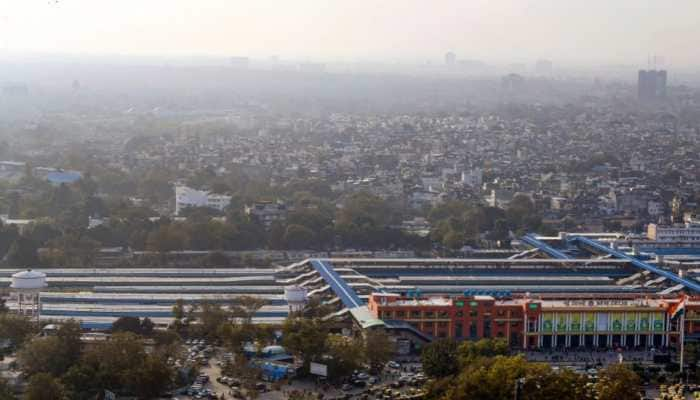INKredible India: The story of 1980 Lok Sabha election - All you need to know
If the 1977 Lok Sabha election showed how voters had largely snubbed Indira Gandhi, the election in 1980 revealed how the Janata Party government had been unable to capitalise on a golden opportunity - paving the way for Indira's return.
Trending Photos
) Photo courtesy: inc.in
Photo courtesy: inc.in The rise of the Janata Party to the political heights of independent India was nothing short of historic. The amalgamation of different political parties to fight Congress, the 21-months of emergency and its injustices, and Indira Gandhi culminated in the country getting its first non-Congress and first coalition government.
The Janata Party government brought with it the promise of a healthy and vibrant democracy after three decades of absolute Congress dominance.
The series of political events which eventually unfolded, however, unleashed familiar allegations of an internal feud, high-handedness and vendetta against rivals against the government. The Janata government would be punished for doing almost all of what the Congress had been punished for in 1977. In fact, Indira even said at a point in time that it was an emergency without the formal declaration of an emergency.
The rise and fall of a government with potential
Almost every leader in the political amalgamation called Janata Party enjoyed enormous respect and projected themselves as one among all. They highlighted their struggles, their pains, their toil and their tussle against widespread injustices – especially accusing Indira of being more of a dictator than a Prime Minister for imposing the Emergency and the eventual excesses against political rivals, students, farmers and even people at large.
It helped the Janata Party win over large parts of north India and make an impact in western parts of the country. The party managed to secure 345 seats after putting up a spirited and united fight.
Unity, however, would contribute to the eventual downfall of this government.
The strongest chain linking parties like Congress (O), Swatantra Party, Bharatiya Jana Sangh and Socialist Party was created by the common objective of highlighting the Emergency and shattering the image of Indira’s political clout. That objective was achieved in the 1977 election.
With the momentous triumph in the bag, the stage was set to take economic and social challenges head-on. Instead, critics say the different political parties that had come together under the Janata Party banner soon began tugging towards different ends. Each of the main four members of the Janata Party had its own ideology and economic outlook. Morarji Desai, a seasoned politician and an important figure in the independence struggle, may have been the apt choice for the PM’s post but he largely failed to keep the party absolutely united. The manifesto before the 1977 election had claimed the Janata Party would hold the price line, revitalise the economy, eradicate poverty in a decade and create social reforms. Most significantly, it had claimed that democracy would be safeguarded and extended.
The alleged political vendetta that unfolded, however, greatly undermined the government in the eyes of the masses while helping Indira regain trust and sympathy.
Not all about the Janata Party government was faulty. Emergency was formally ended, the country looked at improving relations with China and the US while still committing itself to non-aligned principles and the sixth five-year-plan was introduced with a focus on self-reliance. On the flip side of focus on self-reliance, however, major corporations exited the country while problems of inflation, fuel crisis and poverty remained as is.
And while all of these were transpiring, the Janata Party government was also accused of targeting Indira and the Congress in what appeared as revenge tactics. The then Home Minister in Charan Singh ordered for Indira and her son, Sanjay Gandhi, to be arrested on a number of charges, including one that said she had planned to kill opposition members during Emergency. While revenge, as a possible objective, may have been achieved, the government may have bitten more than what it could chew. An enormous backlash unfolded after the arrests with Indira supporters even hijacking an Indian Airlines plane. The backlash eventually made way for a wave of sympathy for Indira who turned her misfortune into her strength.
Apart from the above factors, the Janata Party also had to contend with in-fighting galore. Secular and socialist leaders held views which were almost diametrically opposite to views of Bharatiya Jana Sangh. Key leaders like Atal Bihari Vajpayee and LK Advani were asked by others to choose between being part of the government or being members of the Rashtriya Swayamsevak Sangh (RSS), eventually resulting in their resignation from the government. Support for Morarji from within the party was also on the decline with allegations of his differences with Charan Singh. Charan Singh would eventually resign, pulling out the Bharatiya Lok Dal from the amalgamation. Socialists and secular politicians too began doubting their trust in Morarji.
Due to his deteriorating health, even JP Narayan was unable to calm frayed nerves and act as a unifying force.
All of this led to a wide split in the party and Moraji was defeated in the trust vote in Parliament.
Charan Singh, who had managed to secure the support of some of Janata Party members, took oath as the PM in June of 1979. He was assured support by Congress but the assurance fell through the cracks just two days before he was to prove majority in Parliament. Charan Singh still remains as the only Indian Prime Minister who never faced Parliament, eventually resigning and calling for elections in January of 1980.
Status of states:
The 1980 Lok Sabha election was conducted across 31 states and union territories in India. These were:
Andhra Pradesh
Arunachal Pradesh
Assam
Bihar
Goa Daman and Diu
Gujarat
Haryana
Himachal Pradesh
Jammu and Kashmir
Karnataka
Kerala
Madhya Pradesh
Maharashtra
Manipur
Meghalaya
Mizoram
Nagaland
Orissa
Punjab
Rajasthan
Sikkim
Tamil Nadu
Tripura
Uttar Pradesh
West Bengal
Andaman and Nicobar Islands
Chandigarh
Dadra and Nagar Haveli
National Capital Territory of Delhi
Lakshadweep
Pondicherry
Political parties in the fray:
There were six national parties and another 19 state parties which fought the Lok Sabha election in 1977 – apart from independent candidates. There were also 11 registered (unrecognised parties).
The national parties:
Communist Party of India
Communist Party of India (Marxist)
Indian National Congress (I)
Indian National Congress (U)
Janata Party
Janata Party (Secular)
The state parties:
All India Anna Dravida Munnetra Kazhgam
All Party Hill Leaders Conference
Dravida Munnetra Kazhagam
All India Forward Bloc
All India Muslim League
Jammu and Kashmir National Conference
Kerala Congress
Maharashtrawadi Gomantak
Manipur Peoples Party
Muslim League
Peoples Party of Arunachal
Peoples Conference
Peasants and Workers Party
Revolutionary Socialist Party
Shiromani Akali Dal
Sikkim Congress (R)
Sikkim Janata Parishad
Tripura Upajati Juba Samiti
United Democratic Front
The registered (unrecognised) parties were:
Bharatiya Socialist Party
All India Labour Party
Jharkhand Party
Muslim Majlis
Republican Party of India
Republican Party of India (Khobragade)
Akhil Bharatiya Ramrajya Parishad
Shiv Sena
Sikkim Prajatantra Congress
Shoshit Samaj Dal (Akhil Bharatiya)
Socialist Unity Centre of India
Election 1980:
The Lok Sabha election of 1980 was seen by different parties using different political prisms. For the Janata Party, or what was left of the original design, it was a desperate opportunity to reclaim glory it had floundered in just a matter of three years. Morarji himself opted for political retirement although he did campaign duties. For Janata Party (Secular) under Charan Singh, it was a chance to show that it was a viable third option even as Congress under Indira looked to make the most of the split in main rival camp. It was this split that would play a major role in Indira storming back to power.
“Elect a government that works” became a sloganeering chant for Congress as Indira left nothing to chance and went all (proverbial) guns blazing.
Political parties once again contested for control of 542 seats even though the number of contesting candidates had almost doubled - from 2,439 in 1977 to 4,629 in 1980. The number of polling stations also breached the four-lakh mark for the first time ever.
The size of the electorate – people above the age of 21 – was 35,62,05,329 (or over Three hundred fifty-six million).
The election was held between January 3 and 6 of 1980 and it saw a humiliating rejection of Janata Party and a resounding comeback of Congress.
Congress swept back the so-called Hindi heartland with wins in Haryana, Rajasthan, most parts of Uttar Pradesh and Bihar and Madhya Pradesh. The party also dominated in Maharashtra and Gujarat while in the south – where its performance was strong even in the 1977 debacle, it was an encore. The party won 353 seats in all – one more than what it had managed even in 1971 election, and more than double of the 153 seats it secured in 1977 on its own merit.

Painting a stark contrast to the high notes of Congress, the Janata Party – under Chandra Shekhar - was almost obliterated. It could secure wins in just 31 seats while managing to get 18.97 per cent of the votes. The Janata Party (Secular) fared only marginally better in terms of seats won – 41.
An election which saw voter turnout of figure of 56.92 per cent – a fall by around four per cent from the previous Lok Sabha election – eventually reflected that electors at the time preferred a strong government over an uneasy and edgy coalition government that may have the potential but may lack the common will much needed to take the country and its people forward. This was at least one major conclusion drawn after the 1980 election although the years when coalition governments would rule India were yet to come.
The Lok Sabha election of 1980 is also remembered for being Indira’s last. India in the early years of the 1980s saw mammoth developments that would have deep ramifications for the country, its people, the politics and, perhaps, for Indira herself.
Stay informed on all the latest news, real-time breaking news updates, and follow all the important headlines in india news and world News on Zee News.
Live Tv







)
)
)
)
)
)
)
)
)
)
